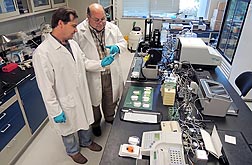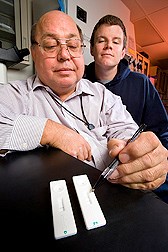Test Strip Quickly Detects Botulism-Causing Toxins
|
|
When someone mentions botulism, most people probably associate this nerve-damaging disease with eating food that was improperly cooked or incorrectly stored. That mode of natural contamination is still of concern. But botulism has also become a homeland security focus, because bioterrorists could use the toxins that cause botulism to make everyday foods and beverages deadly.
The toxins are produced by a common soil-dwelling bacterium, Clostridium botulinum, and several of its close relatives.
Now, a handy test strip that Agricultural Research Service molecular biologist Robert Hnasko and colleagues have developed may give homeland security and food safety officials a powerful tool to use against the toxins. When put to work as the basis of a field-ready test kit, the strip, which measures about a quarter-inch wide by 2.25 inches long, “can provide results in less than 20 minutes,” says Hnasko. He is with ARS’s Western Regional Research Center in Albany, California.
The test is well suited for rapid, preliminary screening in emergency situations, such as a bioterrorist threat or an outbreak of foodborne botulism in which the culprit food has not yet been pinpointed.
“In a crisis, emergency medical technicians or other first-responders could use the test to find out the two things they most need to know: Does the sample they’re screening contain botulinum toxin and, if it does, is there enough toxin in it to kill someone?” Hnasko explains.
|
|
The strip fits snugly into a holder (technically a “lateral flow device”) like those in home pregnancy test kits. Only a small amount of prepared sample is needed, and the results, shown on a color display, are easy to see and understand.
“You don’t need any expensive lab equipment or specialized training to run this test,” Hnasko says. “It’s cheaper, faster, and easier to use than standard lab-based assays. If the situation calls for it, you can use those other tests for confirmation.”
The strip is equipped with laboratory-built proteins, known as “monoclonal antibodies,” that bind exclusively to A or B type (serotype) botulinum toxins. Together, these types are responsible for more than 80 percent of all cases of foodborne botulism in the United States.
ARS biologist Larry Stanker, also based at Albany, led the experiments that yielded the antibodies.
Using monoclonal antibodies in a lateral flow device to detect botulinum toxins isn’t new. However, the test that Hnasko and co-investigators developed is likely the first of its kind that can concurrently detect—and differentiate—the A and B serotypes.
Studies documented in 2012 in the Journal of Immunological Methods demonstrated the strip’s strong performance in detecting A and B toxins that the researchers had deliberately added to samples of milk, apple juice, and orange juice.
Hnasko and Stanker collaborated in the experiments with microbiologist Jeff McGarvey and technician Alice Lin, both at Albany, and with former Albany research associate Katie Ching.
The scientists are continuing to seek collaborations with test-kit developers and manufacturers to expand the test strip’s food, medical, and homeland security applications.—By Marcia Wood, Agricultural Research Service Information Staff.
This research is part of Food Safety, an ARS national program (#108) described at www.nps.ars.usda.gov.
Robert Hnasko is with the USDA-ARS Western Regional Research Center, 800 Buchanan St., Albany, CA 94710; (510) 559-5878.
"Test Strip Quickly Detects Botulism-Causing Toxins" was published in the February 2014 issue of Agricultural Research magazine.








